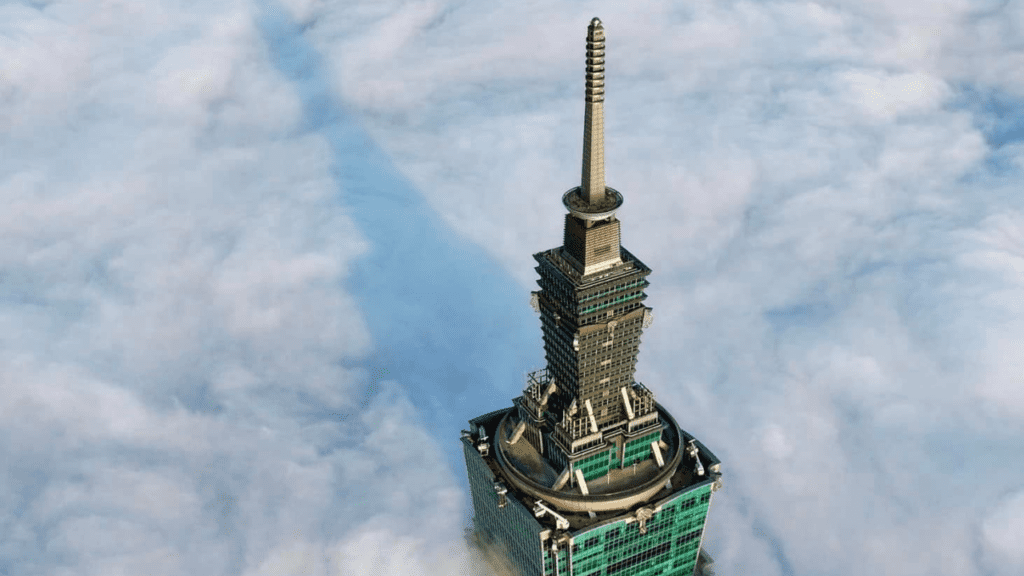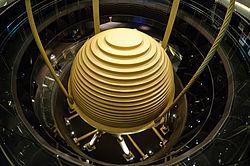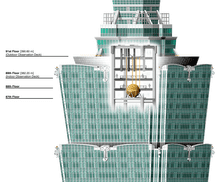
Taipei 101 rises above the clouds. Upon completion in 2004, it became the world’s first skyscraper to exceed half a kilometer (1,667 feet), with 101 floors above ground and five basement levels. It was the world’s tallest building for six years, from March 2004 to March 2010. It is currently the eleventh tallest building in the world. It is the tallest and largest green building in the world, attaining platinum LEED certification for energy efficiency and environmental design in 2011.
The building’s high-speed elevators, manufactured by Toshiba of Japan, held the record for the fastest in the world at the time of completion. It held that record for 12 years, operating at 37.7 mph. The elevators transport passengers from the 5th to the 89th floor in 37 seconds.
Structural Design
Taipei 101 is designed to withstand gale winds of 134 mph and the strongest earthquakes in a 2,500-year cycle. Taipei 101 was designed to be flexible as well as structurally resistant, because while flexibility prevents structural damage, resistance ensures both comfort for the occupants and for the protection of the glass, curtain walls, and other features.
It has the largest wind damper ball in the world. Its 18-foot, 660-metric-ton steel pendulum serves as a tuned mass damper. Suspended and visible from the 92nd to the 88th floor, the pendulum sways to offset movements in the building caused by strong gusts. It can reduce up to 40 percent of the tower’s movements. The ball consists of 41 circular steel plates of varying diameters welded together. Two additional tuned mass dampers, each weighing 6 metric tons, are installed at the tip of the spire which help prevent damage to the structure due to strong wind loads. In August 2015, strong winds from Typhoon Soudelor swayed the main damper by 1 meter, the largest movement ever recorded by the damper.


The damper is a popular tourist attraction, complete with its own mascot: The Damper Baby. Damper Baby has become a popular local icon, with its own comic book and website.
Design Symbolism
Taipei 101’s architectural style evokes traditional Asian aesthetics in a modern structure employing industrial materials.
The height of 101 floors commemorates the renewal of time and lofty ideals: the new century that arrived as the tower was built and by going one better than 100, (100+1).
The main tower features a series of eight segments of eight floors each. In Chinese-speaking cultures, the number eight is associated with abundance, prosperity, and good fortune. The repeated segments recall the rhythms of an Asian pagoda (a tower linking earth and sky), a stalk of bamboo (an icon of learning and growth), and a stack of ancient Chinese ingots or money boxes (a symbol of abundance). The four discs mounted on each face of the building where the pedestal meets the tower represent coins. The emblem placed over entrances shows three gold coins of ancient Chinese design with central holes shaped to imply the Arabic numerals 1-0-1. The structure incorporates many shapes of squares and circles to symbolize yin and yang.
Taipei 101 exemplifies the influence of feng shui philosophy. An example appears in the form of a large granite fountain at the near the tower’s east entrance. A ball at the fountain’s top spins toward the tower. The fountain also serves a practical function in feng shui philosophy. A “T” intersection near the entrance of a building represents a potential drain of positive energy, or ch’i, from the structure and its occupants. Placing flowing water at such spots is thought to help redirect the flow of ch’i.
